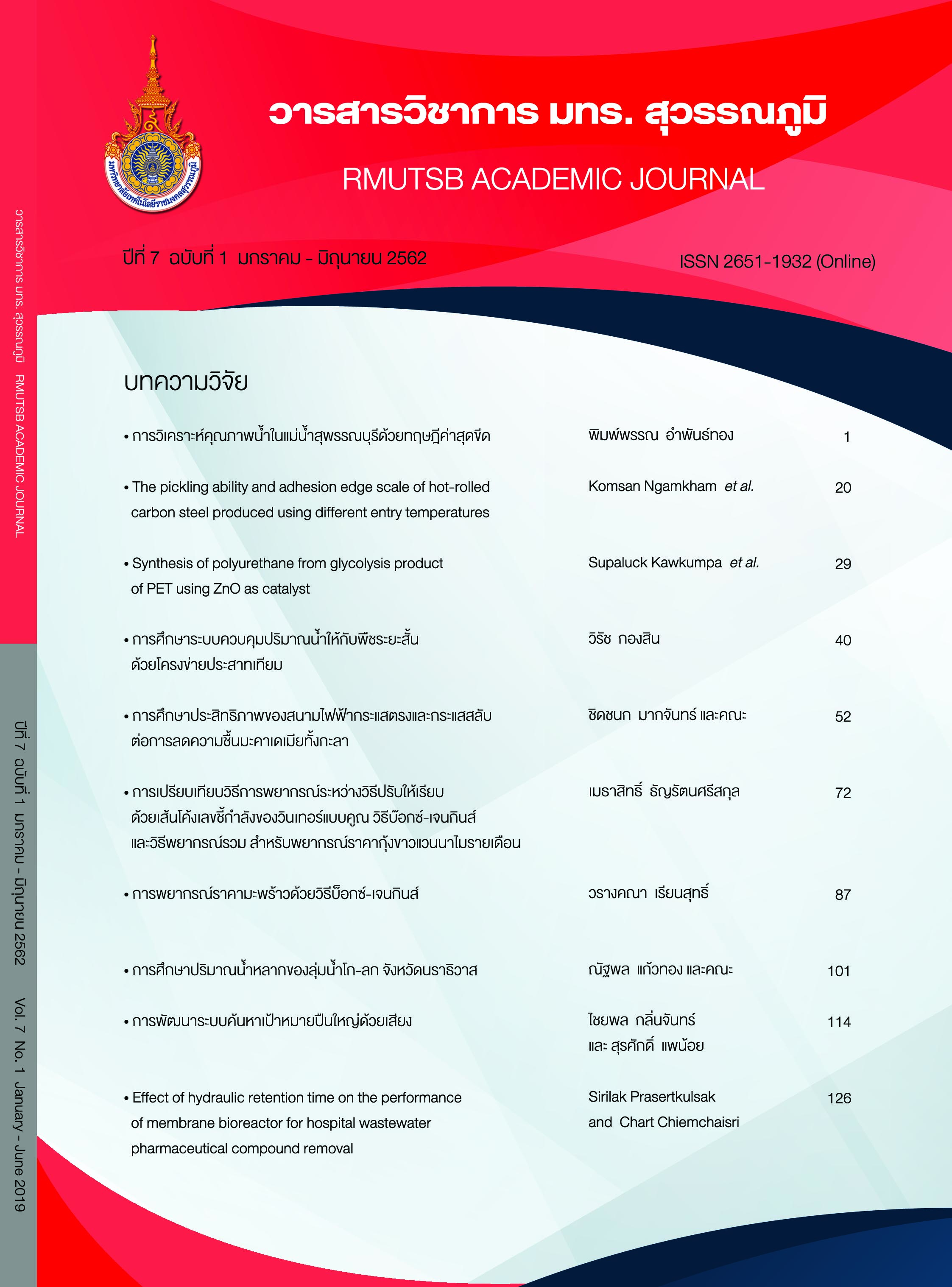Synthesis of polyurethane from glycolysis product of PET using ZnO as catalyst
Main Article Content
Abstract
In this work, zinc oxide (ZnO) nanoparticles were applied as solid catalysts for studying a glycolysis reaction of disposal PET plastic bottles. The effects of temperature, time and concentration of ethylene glycol and ZnO catalyst on % conversion and % yield of Bis(2-Hydroxyethyl) terephthalate (BHET) product were investigated. The chemical structures of the product were confirmed using melting point, Fourier transform infrared (FTIR) and proton nuclear magnetic resonance (1H-NMR) analysis. The glycolysis product was applied with a different ratio of isophorone diisocyanate (IPDI) and polyethylene glycol 400 (PEG400) for the synthesis of polyurethane (PU). The results revealed the optimal condition for the glycolysis, which was conducted at 200 oC for 2 h with the ratio of PET: EG of 1:5 in the presence of 1% wt catalyst to obtain the BHET of about 60% yield. The addition of BHET into PU formulations was to increase their molecular weight, hardness and glass transition temperature (Tg) of prepared PU. This research reveals the possibility of using ZnO nanoparticles as the glycolysis catalysts, and the application of the glycolysis product as an alternative method for reducing plastic waste and preserving the environment.
Article Details
Published manuscript are the rights of their original owners and RMUTSB Academic Journal. The manuscript content belongs to the authors' idea, it is not the opinion of the journal's committee and not the responsibility of Rajamangala University of Technology Suvarnabhumi
References
Al-Sabagh, A. M., Yehia, F. Z., Eshaq, G., Rabie, A. M., & ElMetwally, A. E. (2016). Greener routes for recycling of polyethylene terephthalate. Egyptian Journal of Petroleum, 25(1), 53-64.
ASTM. (2011). ASTM D3363-05(2011)e2, Standard test method for film hardness by pencil test. West Conshohocken, PA: ASTM International.
Cakić, S. M., Ristić, I. S., Cincović, M. M., Stojiljković, D. T., János, C. J., Miroslav, C. J., & Stamenković, J. V. (2015). Glycolyzed poly (ethylene terephthalate) waste and castor oil-based polyols for waterborne polyurethane adhesives containing hexamethoxymethyl melamine. Progress in Organic Coatings, 78, 357-368.
Chen, J. W., Chen, L. W. & Cheng, W. H. (1999). Kinetics of glycolysis of polyethylene terephthalate with zinc catalyst. Polymer International, 48(9), 885-888.
Datta, J. & Kasprzyk, P. (2018). Thermoplastic polyurethanes derivatived from petrochemical or renewable resources: A comprehensive review. Polymer Engineering and Science, 58, E14-E35.
Hood, M. A., Wang, B., Sands, J. M., La Scala, J. J., Beyer, F. L., & Li, C. Y. (2010). Morphology control of segmented polyurethanes by crystallization of hard and soft segments. Polymer, 51(10), 2191-2198.
Imran, M., Kim, D. H., Al-Masry, W. A., Mahmood, A., Hassan, A., Haider, S., & Ramay, S. M. (2013). Manganese-, cobalt-, and zinc-based mixed-oxide spinels as novel catalysts for the chemical recycling of poly (ethylene terephthalate) via glycolysis. Polymer Degradation and Stability, 98, 904-915.
Imran, M., Lee, K. G., Imtiaz, Q., Kim, B. K., Han, M., Cho, B. G., & Kim, D. H. (2011). Metal-oxide-doped silica nanoparticles for the catalytic glycolysis of polyethylene terephthalate. Journal of Nanoscience and Nanotechnology, 11, 824-828.
López-Fonseca, R., Duque-Ingunza, I., de Rivas, B., Arnaiz, S., & Gutiérrez-Ortiz, J. I. (2010). Chemical recycling of post-consumer PET wastes by glycolysis in the presence of metal salts. Polymer Degradation and Stability, 95, 1022-1028.
Ma, S., Liu, C., Sablong, R. J., Noordover, B. A. J., Hensen, E. J. M., van Benthem, R. A. T. M., & Koning, C. E. (2016). Catalysts for isocyanate-free polyurea synthesis: Mechanism and application. ACS Catalysis, 6, 6883-6891.
Phuangngamphan, P., & Thongpin. (2014). Synthesize of polydiacetylene containing copolyurethane using polyol product derived from chemical recycling of PET bottles. Energy Procedia, 56, 326-333.
Sangalang, A., Bartolome, L., & Kim, D. H. (2015). Generalized kinetic analysis of heterogeneous PET glycolysis. Polymer Degradation and Stability, 115, 45-53.
Welle, F. (2011). Twenty years of PET bottle to bottle recycling - An overview. Resources, Conservation and Recycling, 55, 865-875.
Zhou, X., Fang, C., Yu, Q., Yang, R., Xie, L., Cheng, Y., & Li, Y. (2017). Synthesis and characterization of waterborne polyurethane dispersion from glycolyzed products of waste polyethylene terephthalate used as soft and hard segment. International Journal of Adhesion and Adhesives, 74, 49-56.


